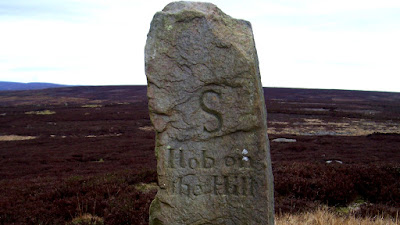The Hob or Hobthrust is a rustic name for a countryside goblin. In Northern England the Hob was viewed as a kind but mischievous spirit, in many stories they are seen as helpful to a specific family or the local people in the village in need of healing.
Much like other types of goblins and trolls if they were caught out in sunlight they would turn to stone. I found there were many connections to scandinavian folklore, even a similar goblin to Hobs known as a Nisse or Tomte, Tomtenisse, or Tonttu.
It is believed that the Hobs were remnants of folklore brought to England by the Anglo Saxons and Scandinavians. Burial grounds, barrows and settlement sites across the North East and Anglo-Scottish border were often named after Hobs - to this day these Boundary Marker stones can be found across the North Yorkshire Moors.
A Boundary Marker stone found on North Yorkshire Moors which has been inscribed as ‘Hob on the Hill’ by Robert Chaloner in 1798
Other places have a direct link to Hobs and Hob related folk tales - usually named as their homes such as the ‘Hob Hole’ caves found along the coast of Runswick Bay and in the cliffs of the North Yorkshire Moors; found on the Yorkshire Moors are the prominent remains of a cairn called ‘Hobthrush Rook’ is said to be the home of a Hob.
Caves in the cliffs of Runswick Bay known as ‘Hob Holes’ due to the belief of Hobs living in them, North Yorkshire, England
The Hob would help a family (usually the family of a farmer or innkeeper) with tasks around the household; they would churn cream into butter, help the farmer thrush wheat or assist the local shopkeeper. They are considered a household spirit similar to Brownies but they are not tied to a particular place but come and go as they please.
According to traditional folklore Hobs preferred to not be seen and so would come out at night but you may catch them in the corner of your eye before they disappear; Hobs are described as small hairy men with large feet, large ears and long messy hair - also completely naked. Many of the folk tales that include Hobs receiving an item of clothing which they saw as an insult and when offended the Hob would either leave the family or become a boggart and terrorise the family.
While the Hobs enriched Yorkshire folklore along with the fairies and barghest, although believed to be true over 150 years ago are now a quaint folk tale among old villages; but thankfully not forgotten.
This is because during the 1800’s a morbid curiosity in the stories of fae and goblin alike began a resurgence; thus it was folklorists who have been able to compile and document these tales that is keeping them alive today for people like myself to discover.
Research Reference:
https://mjwayland.com/hobthrush/
https://hauntedgeneration.co.uk/2019/09/06/hobnobbing-with-the-hobs/
https://www.whitbyonline.co.uk/whitbyhistory/hob.php
https://www.megalithic.co.uk/article.php?sid=47686
Encyclopedia of Fairies in World Folklore and Mythology, Theresa Bane, 2013
Folklore of Yorkshire, Kai Roberts, 2013
Beyond Faery: Exploring the World of Mermaids, Kelpies, Goblins and Other Faery Beasts, John T. Kruse, 2020



No comments:
Post a Comment